Telecommunications History Group Resources
Heroes in Telecom History
Susan Parks - Heroes in Telecom History
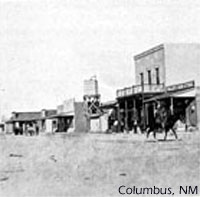 It was only the second invasion by a foreign country since the United States became a sovereign nation. In this case it was a young mother, who was also an extraordinarily bright and brave telephone operator, who played the part of Paul Revere.
It was only the second invasion by a foreign country since the United States became a sovereign nation. In this case it was a young mother, who was also an extraordinarily bright and brave telephone operator, who played the part of Paul Revere.
It was in the evening of March 9, 1916, in the dusty little town of Columbus, New Mexico. The town’s telephone operator, Susan Parks, was asleep with her baby girl in the bedroom of a small wooden house on the town’s main street. The telephone office had burned down in January, but the little telephone switchboard had been saved from the fire and temporarily installed in Mrs. Parks’ bedroom.
Suddenly Mrs. Parks was awakened by the sound of gunfire. She quickly snatched the baby from the crib and put her under the bed. Then she crept to the bedroom window to peek out to where the gunfire was coming from. She saw heavily armed men riding horses, wearing sombreros, firing pistols and rifles at anyone standing in the street. She saw bodies falling to the ground. She was horrified!
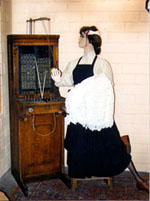 The young operator was witnessing the first invasion of the United States since the British attack on Washington, D.C., in the War of 1812. This time the mounted men Mrs. Parks witnessed shooting down her neighbors were the feared Dorados, “The Golden Ones” of Pancho Villa. She didn’t know it at the time, but the famous Mexican rebel/general himself was leading the raid. (For more information see The Mexican Revolution – Consolidation (1920–40) Part 1)
The young operator was witnessing the first invasion of the United States since the British attack on Washington, D.C., in the War of 1812. This time the mounted men Mrs. Parks witnessed shooting down her neighbors were the feared Dorados, “The Golden Ones” of Pancho Villa. She didn’t know it at the time, but the famous Mexican rebel/general himself was leading the raid. (For more information see The Mexican Revolution – Consolidation (1920–40) Part 1)
A revolution had been going on for some time in Mexico and there had been border skirmishes between United States troops and combatants from both sides of the Mexican revolution. Because of this friction between the two nations, Mrs. Parks knew there was a contingent of United States troops camped in nearby Deming, New Mexico.
Suddenly, Mrs. Parks saw flashes of fire coming from guns aimed at her little house. Bullets shattered the window pane and tore through the thin wooden siding of the house.
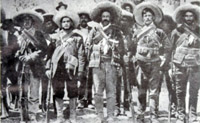 Slowly, the young mother lowered her head below the window sill, turned towards the little switchboard and crept towards it. The room was dark; Susan had not lit the coal oil lamp so she wouldn’t attract attention to the troops outside. Reaching the switchboard the operator stood up and quickly found her headset (receiver). She put it on, pulled up a cord, placed the plug into the jack connecting her to the Deming circuit. She turned the magneto crank to get the attention of the Deming operator.
Slowly, the young mother lowered her head below the window sill, turned towards the little switchboard and crept towards it. The room was dark; Susan had not lit the coal oil lamp so she wouldn’t attract attention to the troops outside. Reaching the switchboard the operator stood up and quickly found her headset (receiver). She put it on, pulled up a cord, placed the plug into the jack connecting her to the Deming circuit. She turned the magneto crank to get the attention of the Deming operator.
The Deming operator answered. Speaking into the transmitter in hushed tones, Mrs. Parks described the horrors going on right outside her bedroom window. After finishing her report, Mrs. Parks hung up and quickly joined her still-sleeping daughter under the bed. It wasn’t until later that she discovered the bullet holes in her switchboard. (See the switchboard’s current home at The Telephone Museum of New Mexico.)
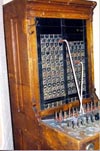 Just like Paul Revere’s ride, Mrs. Parks’ warning unleashed an entire series of events. Capt. A. W. Brock, U.S. Army, was in charge of the troops bivouacked in Deming. He quickly got them mounted and on their way to Columbus 27 miles away.
Just like Paul Revere’s ride, Mrs. Parks’ warning unleashed an entire series of events. Capt. A. W. Brock, U.S. Army, was in charge of the troops bivouacked in Deming. He quickly got them mounted and on their way to Columbus 27 miles away.
While some believe that Villa returned the three miles to Mexico soon after his troops captured Columbus, he left a large contingent of his Dorados behind. Equipped with automatic weapons and some mechanized equipment, Brock’s troops were coming into Columbus as fast as they could. Villa’s outriders spotted the troops and began a fast evacuation of Columbus. They left several burned buildings and 17 dead U.S. citizens. Brock’s men chased the Dorados to the Mexican border, killing several along the way.
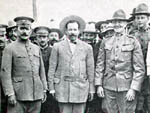 Before he left Deming. Brock had sent an urgent message to General John J. Pershing, at Ft. Bliss in El Paso, Texas. The general quickly mounted his entire corps on a troop train and headed for New Mexico. After arriving in Columbus, Pershing took full control of the Villa campaign. (For more information, see www.epcc.edu.) One of the first things he did, after being informed of Mrs. Parks’ actions during the raid, was to visit the young woman at the telephone office (it was still her bedroom), shake her hand and praise her for her courageous conduct.
Before he left Deming. Brock had sent an urgent message to General John J. Pershing, at Ft. Bliss in El Paso, Texas. The general quickly mounted his entire corps on a troop train and headed for New Mexico. After arriving in Columbus, Pershing took full control of the Villa campaign. (For more information, see www.epcc.edu.) One of the first things he did, after being informed of Mrs. Parks’ actions during the raid, was to visit the young woman at the telephone office (it was still her bedroom), shake her hand and praise her for her courageous conduct.
Later Pershing led a major expedition, complete with armored cars, artillery, airplanes, infantry, cavalry, and Indian scouts. There were also a few Mountain Bell toll patrolmen who had maintained Mountain Bell’s Mexican telephone lines who volunteered to serve as scouts. The expedition was unsuccessful in capturing Villa.
Additional Resources:
See more facts about Susan Parks and the events surrounding this story at the following links:
- For more on Pershing and Villa, visit u-s-history.com.
- To visit the Telephone Pioneer Museum of New Mexico (where a Susan Parks exhibit is housed), see www.nmculture.org.
- For General Pershing’s brief official report dated 30 March 1916 regarding the dispersal of Pancho Villa’s forces, see www.firstworldwar.com.
- Similarly, see www.firstworldwar.com for a biography of Pershing.
- Shortly after his Mexico campaign, General Pershing was named to command the U. S. Army troops in World War I. For more on General Pershing, www.arlingtoncemetery.net/johnjose.htm.
